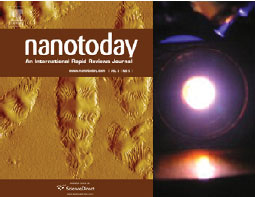Superior LEDs for a Bright Future in NANOTODAY!
A review of the research work on LED integrating semiconductor nanocrystal quantum dots (NQDs) by one of the research teams led by EURYI Assoc. Prof. Hilmi Volkan Demir (EEE, PHYS and UNAM) has recently appeared in NANOTODAY (2011, doi:10.1016/j.nantod.2011 .10.006), which is one of the most prestigious journals in the field of nanoscience and nanotechnology (with a 5-year impact factor of 13.396 as of 2010). Through their collaborative work in the EC Network of Excellence on Nanophotonics for Energy Efficiency and the Singapore NRF Fellowship and CRP programs, team researchers Talha Erdem (PhD student, EE and UNAM), Evren Mutlugün (PhD candidate, PHYS and UNAM) and Dr. Sedat Nizamoğlu (PhD 2011, EE and UNAM; currently on a postdoctoral fellowship at Harvard University), under the supervision of their PhD advisor Dr. Demir, have contributed to the NQD synthesis and LED work.
The rare-earth elements are becoming increasingly essential to a wide range of high-technology industries, including emerging green technologies (e.g., hybrid cars, COx reduction), for a total market that has reached a substantial level on the order of 100 billion USD annually. The photonics industry, providing key enabling technologies in numerous sectors, also contributes to the critical nature of the dependence on rare earths, which make the "special sauce" for light generation and amplification in photonics. As discussed in the recent article "The new oil?" in Nature Photonics, an important example of rare-earth dependence in photonics is the wide use of phosphors of rare-earth ions in white LEDs. Such phosphors are integrated as a color-converting coating to generate broadband emission in the visible spectrum to collectively yield white light generation on LED chips.
 Currently, serious issues regarding continuity in the supply of rare earths may create potentially disastrous effects in the solid-state lighting and backlighting industries, depending on the scale and timing of these issues. What could be a nightmare scenario for the international lighting community may already be starting to play out, particularly following recent governmental decisions on restricting rare-earth export quotas. Finding replacements for rareearth metals has thus become a scientific challenge, especially given that the global demand for rare-earths is expected to double in a few years' time.
Currently, serious issues regarding continuity in the supply of rare earths may create potentially disastrous effects in the solid-state lighting and backlighting industries, depending on the scale and timing of these issues. What could be a nightmare scenario for the international lighting community may already be starting to play out, particularly following recent governmental decisions on restricting rare-earth export quotas. Finding replacements for rareearth metals has thus become a scientific challenge, especially given that the global demand for rare-earths is expected to double in a few years' time.
Fortunately, when it comes to finding replacements for the rare-earth phosphors used in white LEDs, the situation does not look so bad. Pioneered by Assoc. Prof. Demir’s research team, there is a likely potential alternative: semiconductor NQD emitters. Because of their relatively easy synthesis, solution processability and unique optical properties, NQDs are foreseen to be the strongest candidates to substitute for phosphors in white LEDs. Among the favorable optical properties of NQDs are their comparatively narrow emission bands, enabling color purity and precise tunability of color, thus allowing for color quality.
Thanks to these competitive advantages, in a paradigm shift, NQD emitters have made it possible for the Demir Group to achieve photometrically efficient, high-quality color-conversion LEDs, together with their lab at NTU Singapore (with which Bilkent has recently signed a Memorandum of Understanding). These superior white LEDs based on NQDs beat conventional incandescent light bulbs, fluorescent lamps and phosphor-based white LEDs in terms of photometric efficiency as well as color quality.